Put Your Functional Fashion Foot Forward
By Molly Cohen, Fashion Archives Intern 2018
The emergence of female designers in ready-to-wear, off-the-rack fashion helped set the tone for the latter half of the 20th century: functionality informed the form. As girdles and garters were shed, they were replaced with breathable and movable fabrics, designed for a true human to wear, not the ideological feminine body we had forced into corsets and crinoline cages for centuries.
The Wrapper.
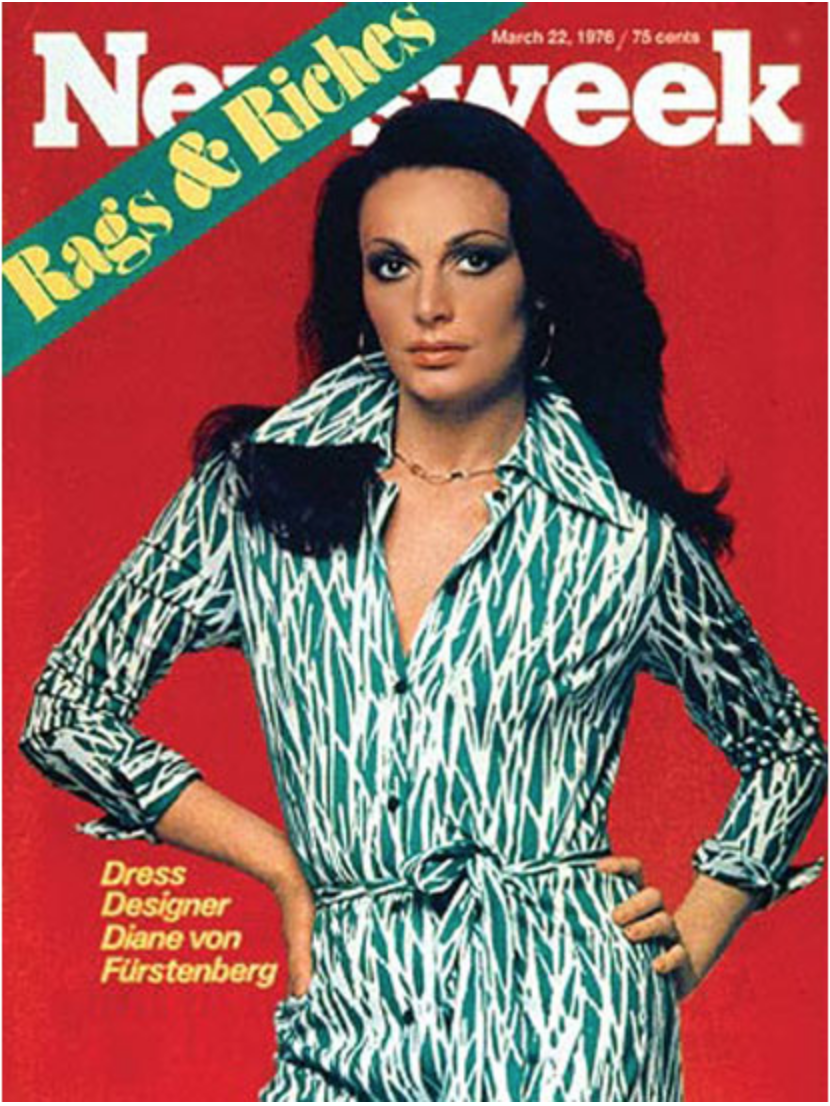
Diane Von Fürstenberg on the Cover of Newsweek, March 1976. Photo Courtesy of The New York Times.
Designer Diane Von Fürstenberg became a near overnight sensation when she patented her wrapper pattern in New York in 1974. Fürstenberg, the epitome of the American Dream, created and patented the wrap dress in 1974 to flatter all figures while allowing ease of movement in a slimming silhouette. The wrapper, now considered one the most timeless silhouettes to have emerged from the modern fashion era, is a relatively simple garment that uses a woman’s natural waist, hips, bust, and shoulders as a guiding point for the fabric to drape. When looking back at her legacy, Marie Claire noted that the wrapper is a “dress which is suitable for every kind of body type, that immediately makes us feel classy and ready for every occasion, it is a dress which has been worn by thousands of women, hundreds of celebrities, that was painted in every kind of colour and experimented with in all types of patterns” (marie claire 2016).
But what made this gown a closet, and cultural, staple? The answer is simple. The sheer simplicity of the dress and its ability to translate and transform from work to dinner, to a party, to a date. “In 1976, two years after its introduction, Diane von Fürstenberg was producing 20,000 rayon and cotton jersey wrap dresses a week. Disco dollies loved these slip-on, slip-off dresses. ‘Simplicity and sexiness, that’s what people want,’ the designer told Vogue. ‘At a price that’s not outrageous.'” (Vogue).
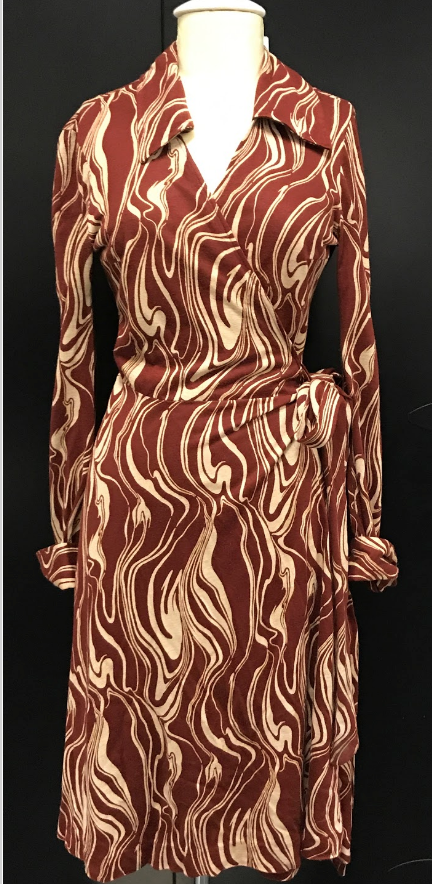 Maroon and cream swirl wrapper, Diane Von Fürstenberg, Italy, c. 1975, acrylic, Maryland Historical Society, Gift of Gregory Weidman, 1987.126.4.
Maroon and cream swirl wrapper, Diane Von Fürstenberg, Italy, c. 1975, acrylic, Maryland Historical Society, Gift of Gregory Weidman, 1987.126.4.
The wrapper that was recently discovered in The Maryland Historical Society (MdHS) Fashion Archives is a true original, purchased within one year of Fürstenberg’s design hitting the racks. The fit, fabric quality, and print are extremely similar to very one Fürstenberg is wearing in the Newsweek photograph, famously considered “The True Original Wrapper”. This overall swirl print became very popular because Fürstenberg’s capitalized on the mid 1970’s fad of bright colors and designs, and even now the wrapper and its myriad versions are prevalent in fashion.

Maroon and cream swirl wrapper label, Diane Von Fürstenberg, Italy, c. 1975, acrylic, Maryland Historical Society, Gift of Gregory Weidman, 1987.126.4.
From this label, we are able to gather important information about the wrapper and its intended use. It reads, “100% ACRYLIC. Hand Wash in Cool Water With Mild Dish Detergent. Rinse Thoroughly Keep Water Clear of Excess Dye. Dry Flat No Bleach. MADE IN ITALY. Size 12”. Acrylic fabric is a synthetic fiber, but it acts as a soft, lightweight, breathable, more affordable option to wool, or a wool blend.
The use of acrylic would help ensure that costs for Diane Von Fürstenberg wrappers were that which the modern working woman could afford. It doesn’t pill or fray as much as other synthetic fibers and takes dye very well, allowing its longevity to be taken into consideration upon making it. The label clearly acknowledges that the women wearing these wrappers were go-getters who were always on to go and savvy spenders. Therefore, Diane Von Fürstenberg wants to reassure the consumers that their dresses won’t get ruined; reinforcing the idea to only use “mild dish detergent” if they must resort to soap to launder their wrapper.
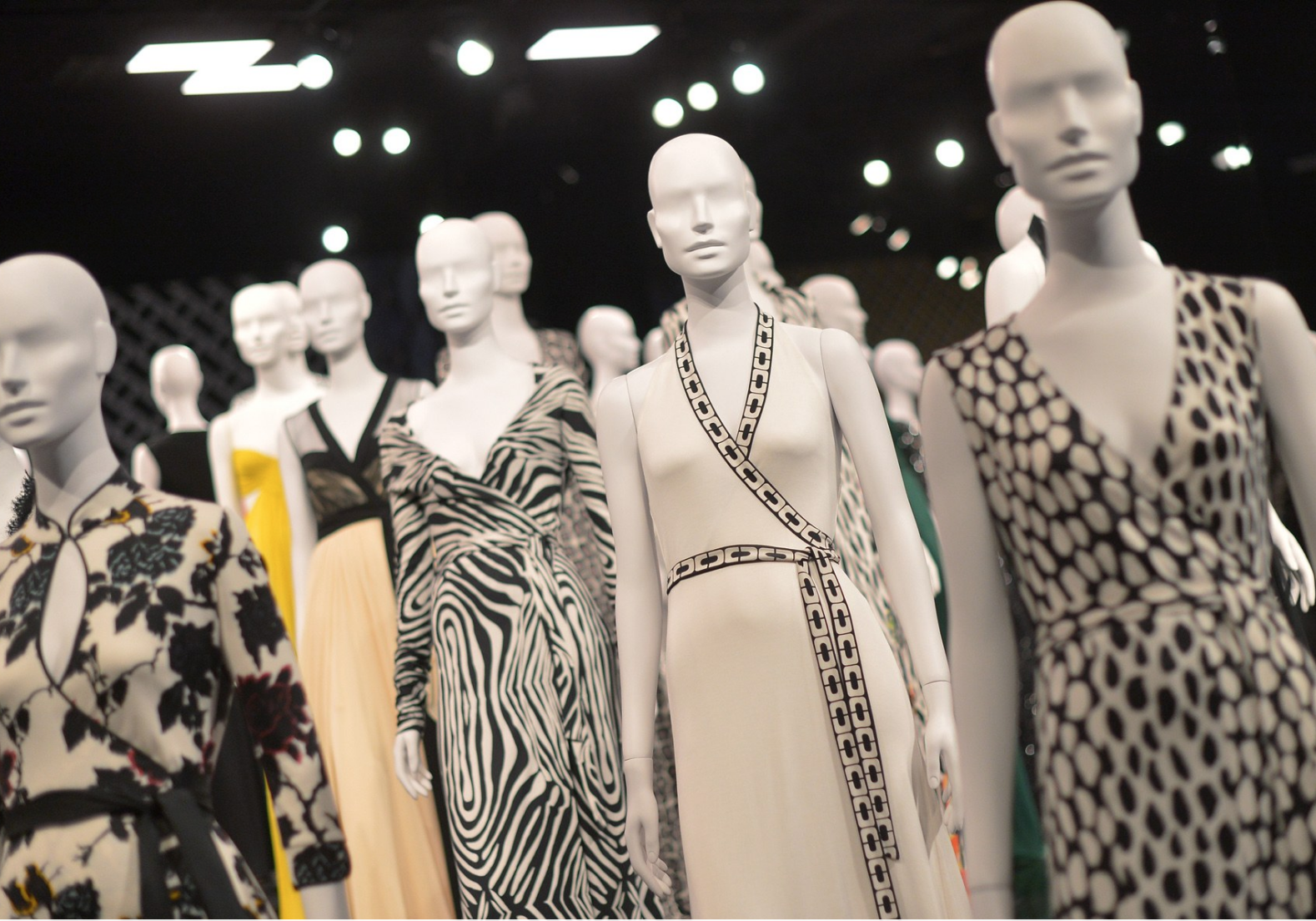
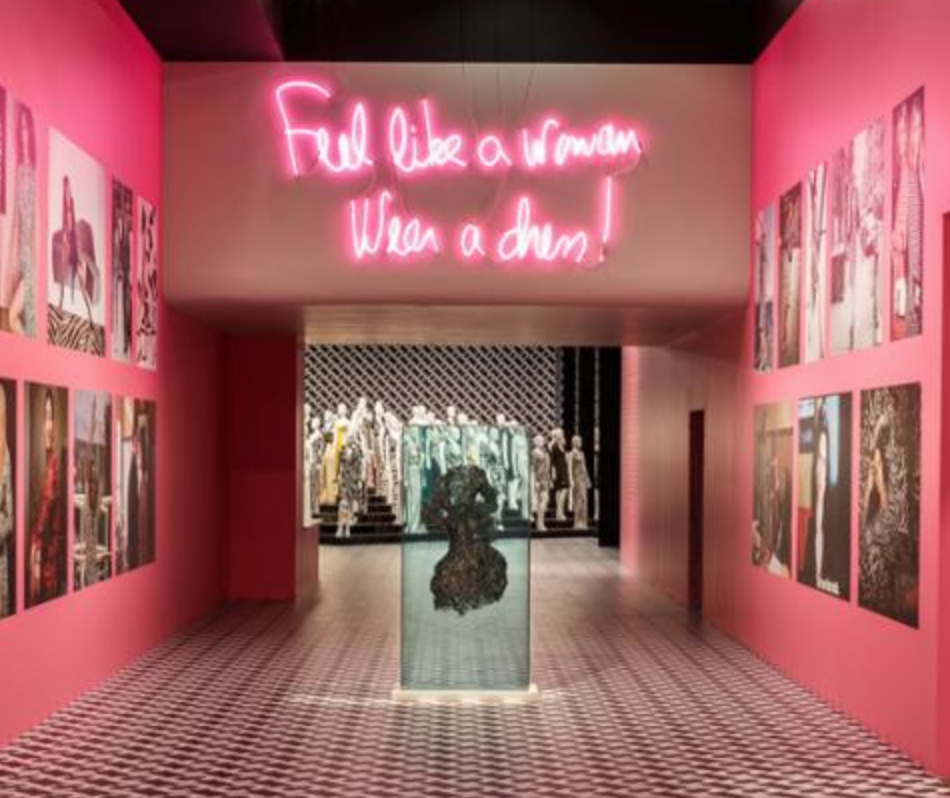
Left: A general view of the atmosphere during Diane Von Furstenberg’s Journey of A Dress Exhibition Opening Celebration at May Company Building at LACMA West on January 10, 2014 in Los Angeles, California. Photo by Charley Gallay/Getty Images for Diane Von Furstenberg. Courtesy of Vogue.
Right: “Feel like a woman, wear dvf!” in neon pink LED light in the atrium of Diane Von Fürstenberg’s Journey of a Dress Exhibition in Wilshire May Company Building in Los Angeles, 2014. DVF Photography, Courtesy of CNN.
An exhibit celebrating Diane Von Fürstenberg’s work opened in 2014 in Wilshire May Company Building in Los Angeles. “A Journey of a Dress” honors her work of 40 years in fashion, material culture, cinema, pop culture and more. Guests showed up in so many different iterations of Fürstenberg designs, speaking to how many people she dresses and appeals to.
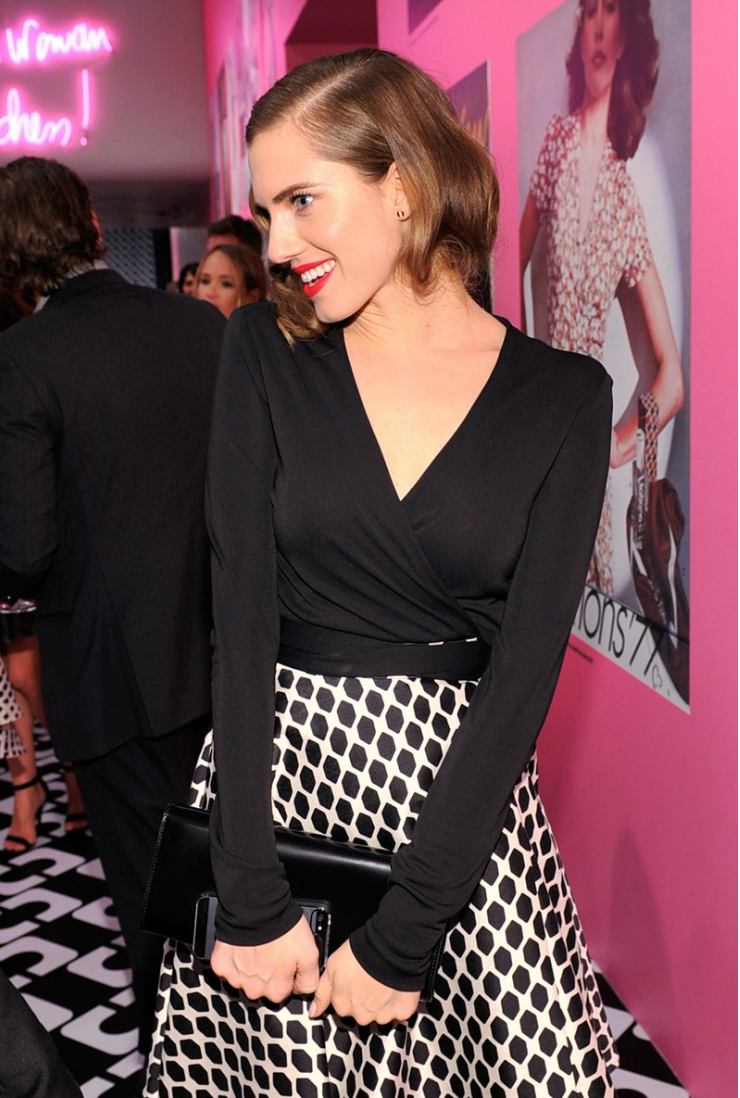 Actress Allison Williams, wearing Diane Von Furstenberg, attends Diane Von Furstenberg’s Journey of A Dress Exhibition Opening Celebration at May Company Building at LACMA West on January 10, 2014 in Los Angeles, California. Photo by Donato Sardella/Getty Images for Diane Von Furstenberg. Courtesy of Vogue.
Actress Allison Williams, wearing Diane Von Furstenberg, attends Diane Von Furstenberg’s Journey of A Dress Exhibition Opening Celebration at May Company Building at LACMA West on January 10, 2014 in Los Angeles, California. Photo by Donato Sardella/Getty Images for Diane Von Furstenberg. Courtesy of Vogue.
Her designs translate to different art forms, such as a wallpaper seen below, adding pops of brightness, color, and life as a way to expand her influence in the daily lives of her clients. Her print from the dress she wore on her infamous Newsweek cover was turned into a wallpaper, detailing how expansive her reach in our society has become.
 Jessica Joffe, wearing Diane Von Furstenberg, attends Diane Von Furstenberg’s Journey of A Dress Exhibition Opening Celebration at May Company Building at LACMA West on January 10, 2014 in Los Angeles, California. Photo by Stefanie Keenan/Getty Images for Diane Von Furstenberg. Courtesy of Vogue.
Jessica Joffe, wearing Diane Von Furstenberg, attends Diane Von Furstenberg’s Journey of A Dress Exhibition Opening Celebration at May Company Building at LACMA West on January 10, 2014 in Los Angeles, California. Photo by Stefanie Keenan/Getty Images for Diane Von Furstenberg. Courtesy of Vogue.
A major part of the exhibit featured over 200 vintage and new designs, exhibited on platforms throughout the space. These are positioned like Terracotta warriors, in both stance and placement.
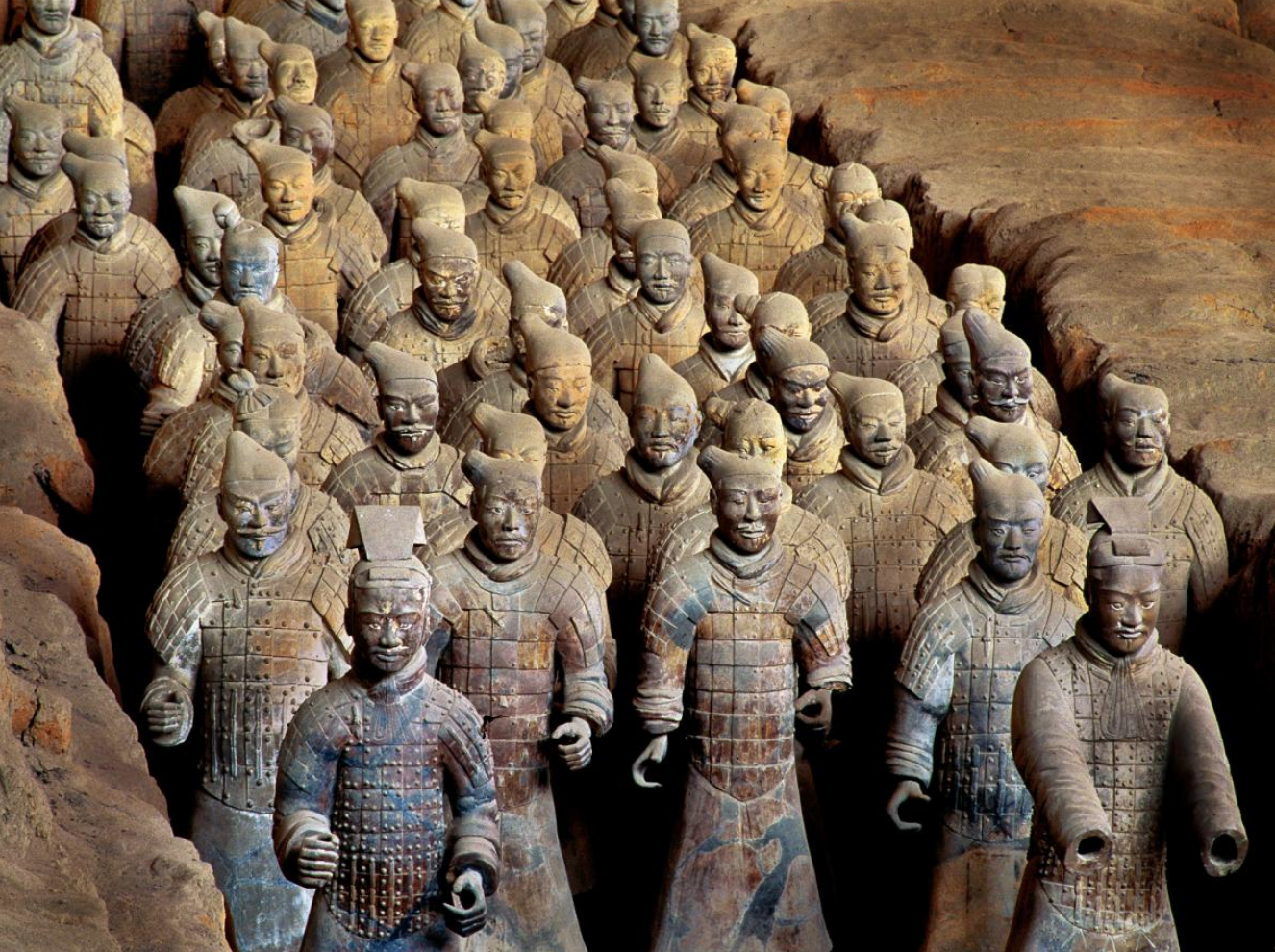
Platoons of clay soldiers were buried with China’s first emperor, Qin Shi Huang Di, to accompany him during his eternal rest. Photograph by O. Louis Mazzatenta, Courtesy of National Geographic.
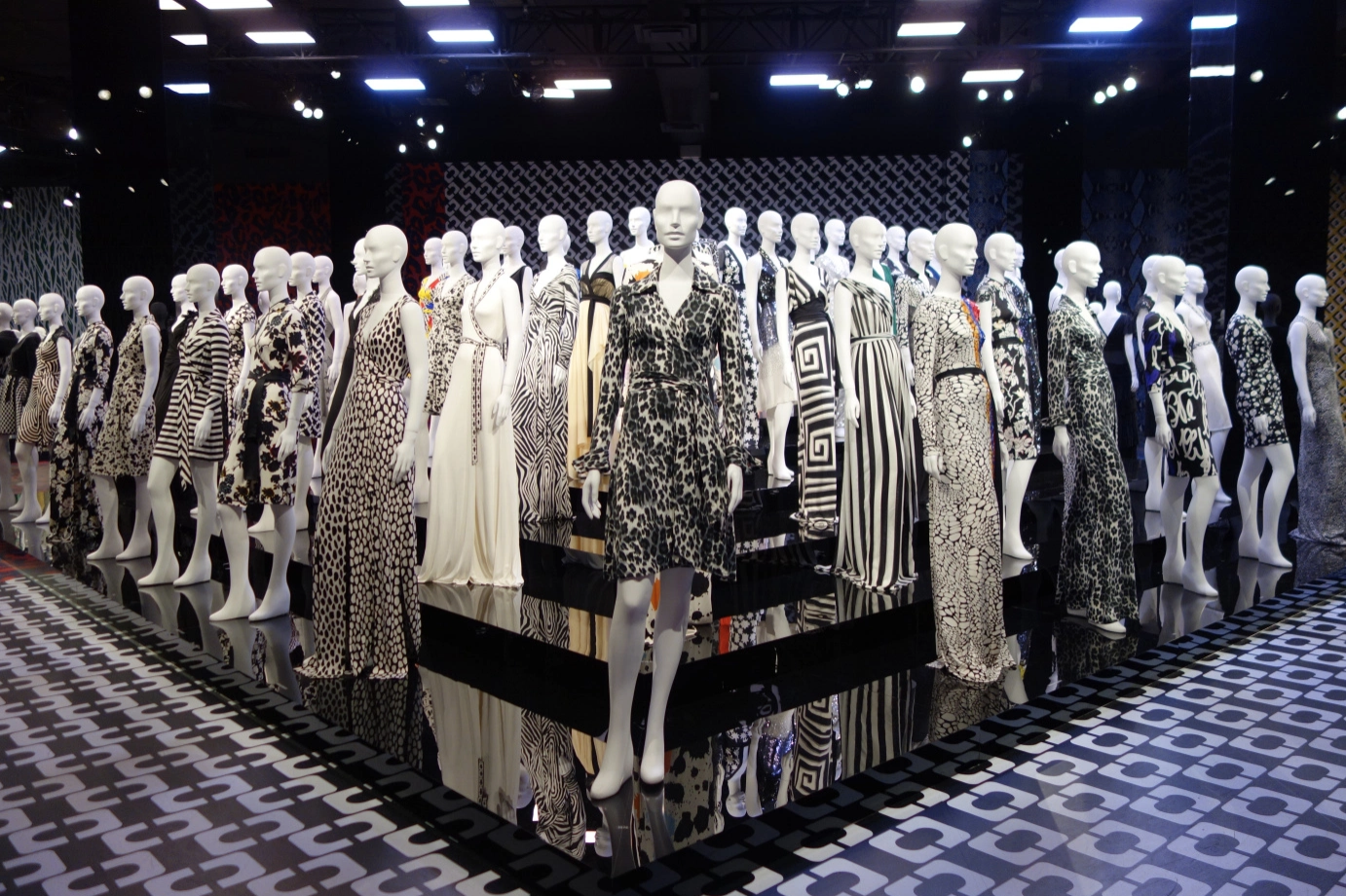
Army of Terracotta Wrap Dress Warriors, exhibition featuring vintage and contemporary designs in Diane Von Fürstenberg’s Journey of a Dress Exhibition in Wilshire May Company Building in Los Angeles, 2014. DVF Photography, Courtesy of CNN.
Fürstenberg stated she “wanted a wrap dress army, just like the Qin army of terracotta warriors. I love the idea of the woman warrior, and you see that also in the pose of the mannequins. It’s strong. Strength was the most important thing for me. That’s what I like to get out of women. The wrap dress is popular culture. I never really tried with this dress to make a fashion statement, but this dress is now talked about in sociology classes. It is associated with liberation.”
New Call-to-action
References:
http://www.xfashion.today/celebrity/inside-dvfs-journey-dress-exhibit.html
https://www.vogue.com/slideshow/cult-dresses-in-fashion-dressgate#4

